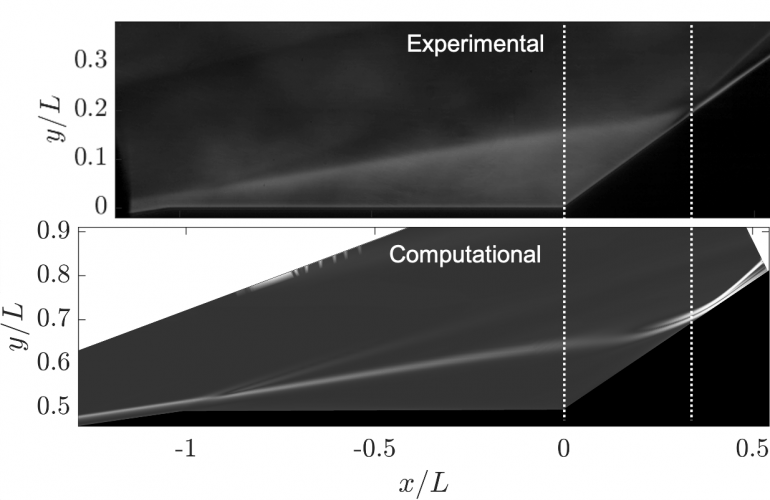Published: Dec 12, 2022 by Daning Huang
We have been expanding our study of hypersonic aerothermoelasticity, or more generally high-speed fluid-thermal-structural interaction (FTSI), with more complex and realistic flow physics, e.g., acoustic radiation of turbulent flow, shock wave/boundary-layer interaction, and shear layer oscillations.

To tackle these problems, we resolve the complex flow phenomena using higher-fidelity tools such as Large Eddy Simulation (LES) and implicit LES, in a setting that is coupled to other physical domains, i.e., structural dynamics and conjugate heat transfer.
For example, in one of our recent works, we collaborated with experimentalists from Sandia National Labs (SNL) and numerical analysts from US Air Force Academy (USAFA) to investigate the FTSI a cone-slice-ramp (CSR) geometry with a wedge angle of 30 degrees subjected to a low Reynolds number inflow at Mach 8. The computational costs are kept tractable by decomposing the numerical frameworks into a quasi-steady FTSI (QS-FTSI) analysis and a transient fluid-structure interaction (FSI) analysis, leveraging the time-scale disparity. The time-resolved and the time-averaged solutions obtained from the laminar fluid solvers are validated to assess the modeling accuracy of the mean flow features and their unsteady characteristics.

- The predictions show all the major flow features generated on the CSR with low-frequency oscillation and the shear layer flapping at a higher frequency, as well as upstream and downstream legs of streamwise vortices that cannot be easily observed in the experiment.
- The QS-FTSI analysis accurately reproduces the experimental results and reveals the streamwise vortices to be the dominant source heating the structure.
- The transient FSI analysis reproduces the dominant structural frequencies and reveals the oscillating shear layer to be the dominant driving force for the compliant panel.
The findings lead to further investigation of the flow mechanisms, which is to be accomplished by analysis techniques for spatiotemporal data.
For more details see our work SciTech2021, SciTech2022, AIAAJ2023, SciTech2024.
We have an array of works that involve a broad range of collaborators from SNL, USAFA, Univ. of Michigan, etc. Relevant funds: SNL